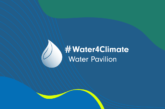
Dr Arvind Kumar* President, India Water Foundation, New Delhi.
The Sustainable Development Goals (SDGs), adopted by UN General Assembly in the last week of September 2015, aim to build upon and expand the millennium development goals (MDGs) while making sustainable development a reality. Many analysts feel that the 17 SDGs along with 169 targets, from ending hunger to providing water and sanitation for all, and an estimated cost of around $2-3 trillion annually attached to achieving these ambitious goals, one cannot expect governments and civil society alone to meet the challenge and it will require capital markets and global investors to play crucial role in realizing these targets.
Business in general and finance in particular, has a critical role in ensuring that the goals are met within a stipulated period. The SDGs have great aspirations for the roughly $150 billion worth of official development assistance (ODA). However, it is opined that more needs to be done to harness the roughly $300 trillion of capital in the global markets in a way that will help to achieve these goals.
 One analyst has pointed out that while rummaging through a vast array of the presentations made at different events that have led to the adoption to the SDGs, three points have seemingly emerged more prominently. In the first instance, few presentations have provided any indication of serious learning from the wins– and losses–during 15 years of MDG work. A delineation of the models that are more sustainable and scalable is seen as clearly missing from the SDGs. Secondly, in the absence of learning frameworks, presenters have reiterated the same problems, now expanded to 17 SDGs goals and 169 targets. The resultant outcome is discernible in the form of a plea that emphasizes on more resources to support the new SDGs without any evidence that those resources will be employed more effectively. Thirdly, the core request at these events was for more than four trillion dollars per year to implement the SDGs over 15 years.
One analyst has pointed out that while rummaging through a vast array of the presentations made at different events that have led to the adoption to the SDGs, three points have seemingly emerged more prominently. In the first instance, few presentations have provided any indication of serious learning from the wins– and losses–during 15 years of MDG work. A delineation of the models that are more sustainable and scalable is seen as clearly missing from the SDGs. Secondly, in the absence of learning frameworks, presenters have reiterated the same problems, now expanded to 17 SDGs goals and 169 targets. The resultant outcome is discernible in the form of a plea that emphasizes on more resources to support the new SDGs without any evidence that those resources will be employed more effectively. Thirdly, the core request at these events was for more than four trillion dollars per year to implement the SDGs over 15 years.
The prevalent scenario plausibly leads to two important questions. The first question is as to how these SDGs goals replacing the MDGs can be called as sustainable if they lead with requests for resources that are not easily accessible. Secondly, at the initial stage of implementing of the SDG process, what should the global governments, corporates and NGO leaders focus on now to make the new SDGs actually sustainable?
Social Entrepreneurship and SDGs
According to one report, societal business search firms have advocated tirelessly the need to identify models that are scalable and not donation-dependent and driven by the dictates of donors. Social entrepreneurs have been credited by some analysts for developing viable models which are said to be sustainable.
It is further revealed from the report that the social entrepreneurs are relentlessly focused on what they have learned. They work out the innovations that are rolled into ingenious, often cross-sector models and as the people who use these models to solve their own and others problems. Their resource requests are framed by why their model should be scaled and how it can replace less effective approaches. It is also reported that the avowed objective of these innovative social entrepreneurs is to demonstrate that appropriate capacity building and scale enables their hybrid or for-profit innovation models to solve problems sustainably, thus reducing dependence on fundraising.
It is observed from the report that the social entrepreneurs have already offered five critical solutions to the problem of making the SDGs truly sustainable. In the first, it is to be recognized that any commitment to achieving the SDGs must avoid Einstein’s famous definition of insanity: Doing the same thing and expecting different results. “Secondly, authentic commitment to the SDGs requires leaders to recognize one simple reality: It is not possible to have sustainable development goals without sustainable models that leverage under-utilized resources.”
Thirdly, while recognizing that the current donor, foreign aid and resource investment processes are not sustainable, serious SDG innovators call attention to inadequacies and offer new models and leadership to move significant resources from unsustainable models to sustainable models. Fourthly, “any leader pleading for more funding should be able to explain how his/her organization will deploy that funding to scale solutions that are more sustainable than those that failed to achieve most of the MDGs.” Finally, “significantly improved sustainability requires the ongoing evaluation of all investments, models and approaches employed. The most sustainable solutions should then be aggressively adopted across sector and country boundaries, no matter their origin or disruption.”
Some analysts point out that the social entrepreneurs thrive at risk taking and from learning rapidly about what doesn’t work and they usually offer the sustainable, scale-oriented models and management teams that are adequately equipped to handle significant capital and to shift how these goals are achieved to sustainable development goals.
Need for More intra-UN coordination
Emphasis on more coordination within the UN systems has been stressed by Yoriko Yasukawa, the United Nations Population Fund’s (UNFPA) regional director for Asia and the Pacific in order to raise capacity to help countries achieve sustainable development goals. She has further opined: “The countries are demanding that we work together to move forward this big agenda as a whole. The UN system is going to need to be much better. We need to raise the level of our technical and intellectual capacity to really help countries achieve their priorities.”
While underscoring the role of countries that lead SDGs and the help rendered by the UN systems to achieve those goals, Yasukawa further asserts that within the countries, it is the people who will demand development rights, where civil society and media can play an important role to work in coordination and coherence. She further adds: “We need to do that because these are very ambitious goals and they will need lots of additional resources, but at the same time by working together more closely and eliminating inefficiencies, learning from one another, we together can define the best course of action, and in that case we can do much more with the same amount of resources.
Effective Monitoring Required
Some experts from the United Nations Development Programme (UNDP) have opined that the success of SDGs hinges on robust monitoring because a robust monitoring framework will be crucial for a country to reach sustainable development goals and ensure scarce resources are well-spent. According to them, a rigorous outcome-oriented monitoring and evaluation framework has to be developed, one which accommodates and promotes participation from the remotest and most marginalised communities and thereby ensure accountability at all levels.
According to some observers, it is significant that the voices of civil society organizations (CSOs) and private sector are heard and incorporated in the goal-specific country level plans and simultaneously, the CSOs and the private sector need to have a role to play in the implementing and monitoring of the SDGs.
It has argued that aligning the national goals with the SDGs and engaging the lower levels of government in the implementation process would be a step in the right direction. There is need for inter-ministerial synergy because achieving the goals is not the responsibility of a single ministry; all ministries and government departments have to play their due role. Similarly, all the UN agencies are also called upon to play their due role. While according priority to domestic resource mobilization by the concerned countries, official development assistance (ODA) will remain crucial, especially for the least-developed countries.
According to broad estimates, the implementation of the SDGs would require three times more resources than the MDGs and it will be challenge for developing countries because these countries will have to double their public spending for infrastructure and social projects. In the context of a developing country, the government alone cannot implement the SDGs owing to availability of limited financial resources at its disposal, Hence it needs active support of the domestic private sector for which it will have to incentivize the private sector.
Effective implementation of the SDGs calls for proper monitoring because the effective use of resources can be ensured through monitoring. Proper monitoring is a crucial factor because a one-dollar resource well-spent can give a 10-dollar outcome. Monitoring, especially done by communities, can bring about accountability and transparency and empowerment of civil society organizations.
Availability of up-to-date good-quality data is essential to monitor the progress of the SDGs. The role of data would be crucial in achieving the SDGs as there will as many as 400 indicators under the goals. Reliable data is required to measure the progress of the SDGs, collecting quality data and their timely dissemination would be a major challenge as everybody wants real-time data.
Presence of strong institutions is equally important and without them one will not be able to deliver what one intends to deliver. This also necessitates the presence and involvement of CSOs as partners and not as rivals in a country’s efforts to achieve the targets of the SDGs.
Way Ahead
Undoubtedly, the adoption of the SDGs by the UN General Assembly has unfolded new vistas of opportunities for a batter world devoid of inequalities, deprivations, exploitation and mitigation of climate-induced catastrophes; nevertheless, attainment of these goals is not an easy task. Paucity of funds, lack of technological capabilities with developing countries to harness their potential by integrating these goals into their national development strategies and absence of clear and transparent models to adapt these goals to local conditions etc., are some of the major obstacles that may confront developing countries in realizing this vast array of targets within the stipulated period.
Broad estimates show that about 2 to 3 $ trillion per year are required to implement the SDGs from the onset of 2016 onward. Undoubtedly, a handful of countries such as the UK, Sweden and Norway had honoured the commitments in case of MDGs; nonetheless, the question arises as to these countries along with OECD are in a position to finance the MDGs, especially at a time when global economic slowdown is adversely impacting the economies of these countries. The developments obtaining in 2016 will certainly provide partial answer to this question and till then let’s wait and watch.



